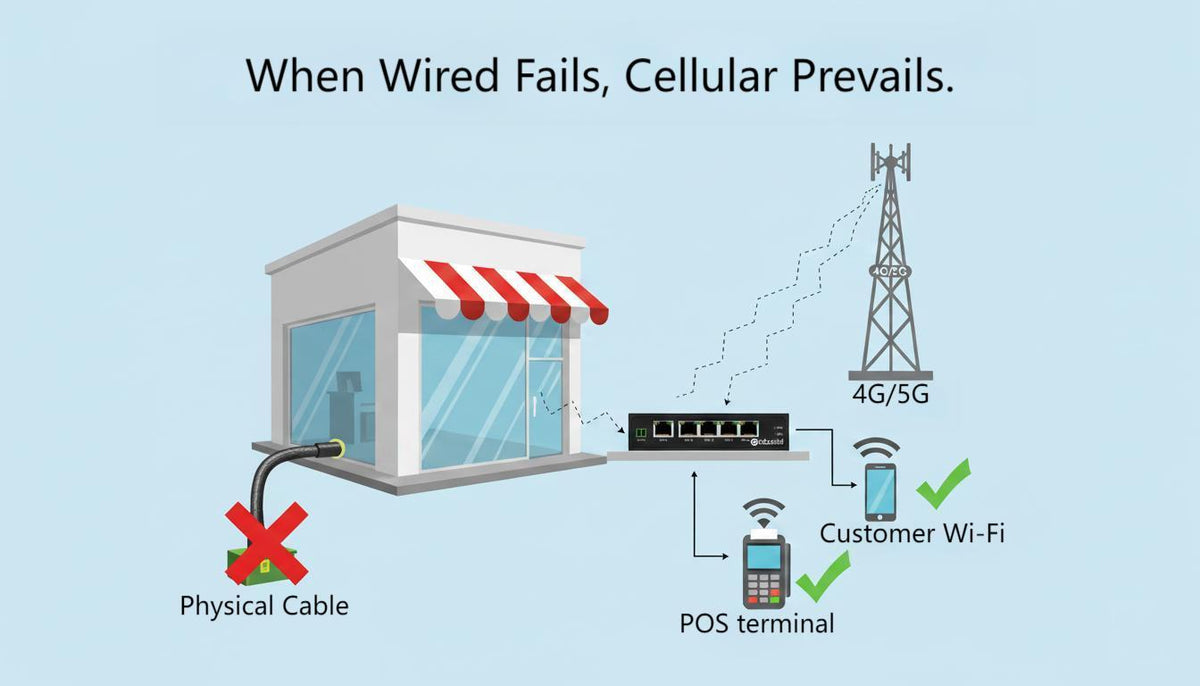
What is WAN Failover? A Guide to Unbreakable Internet Connectivity
|
|
Time to read 5 min
|
|
Time to read 5 min
WAN failover is a critical technology that serves as an automated "Plan B" for your internet connection. It works by having a router automatically switch your network's traffic from a primary wired connection (like fiber) to a secondary backup connection (like 4G/5G cellular) the moment an outage is detected. This ensures true business continuity, turning potentially catastrophic internet downtime into a minor,
WAN failover is a function that automatically redirects traffic to a backup internet source when your primary source fails, keeping your business online.
Using a cellular 4G/5G connection as the backup is the most effective strategy because it provides true "path diversity," meaning it's completely independent of the physical cables that can be cut or damaged.
A professional WAN failover solution can switch connections in under 30 seconds and is fast enough to run an entire branch office, including POS terminals, VoIP phones, and cloud applications.
For any business that relies on a constant internet connection, it's a low-cost insurance policy against significant financial and reputational damage.
Picture this: It's the busiest time of day at your retail store, and suddenly, the credit card terminals stop working. The customer Wi-Fi is down. Your point-of-sale system can't connect to the central inventory. Outside, a construction crew has accidentally cut the fiber optic cable that serves your entire block. Your business is completely dead in the water until a technician can fix it, which could take hours, if not days.
I've seen this exact scenario cripple businesses. In today's world, a stable internet connection is as essential as electricity. A single point of failure is no longer an acceptable risk.
The solution? It's a simple, powerful, and surprisingly affordable strategy called WAN failover . Let's break down what it is and why it's the ultimate insurance policy for your business.

At its heart, WAN failover is an automated process managed by a specialized router, often called a dual-WAN router.
The entire process is automatic. For the people using the network, the transition is often completely imperceptible.
Getting a new wired business internet line installed can take weeks. A cellular internet backup solution can be deployed in minutes.

When you're ready to implement this strategy, look for a router that offers these critical features.

This isn't just theory. A national financial institution deployed a Robustel 5G WAN failover solution across its 500 branches. The results were transformative:
In a world where internet connectivity is the lifeblood of business, WAN failover is no longer a luxury for large enterprises. It's an accessible, affordable, and essential strategy for any organization that cannot afford to be offline.
By using a professional industrial router to combine a primary wired connection with a secondary cellular backup, you are purchasing the most valuable insurance policy available: the guarantee of business continuity.
Learn More in our main guide:
A1: It's nearly instant. A professional router can typically detect an outage and switch over to the cellular backup in under 30 seconds. For most applications and users, this transition is seamless and unnoticeable.
A2: It's surprisingly affordable. The cellular data is only consumed during an actual outage. Given that M2M/IoT data plans are very competitive, the monthly cost is minimal compared to the cost of even a few minutes of lost business during an outage.
A3: This is a great question. WAN failover switches between different types of internet connections (e.g., wired Fiber to wireless Cellular). Dual-SIM failover switches between two different cellular carriers on the same device. A highly resilient setup will actually use both: a primary wired connection that fails over to a router with two SIM cards for ultimate redundancy.